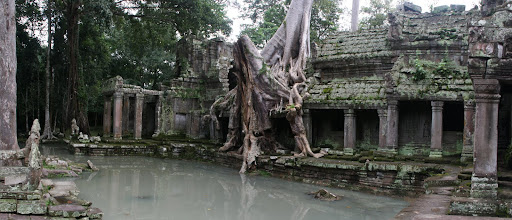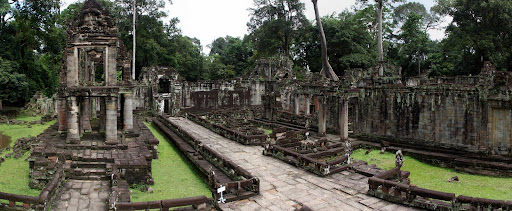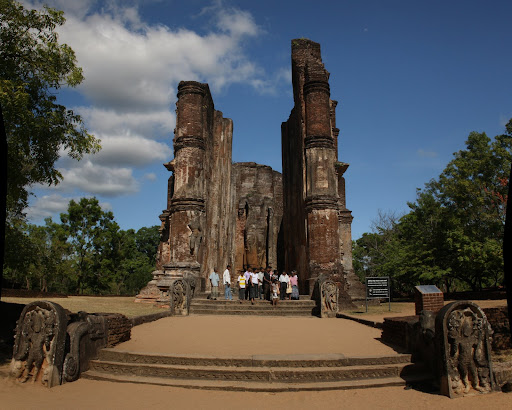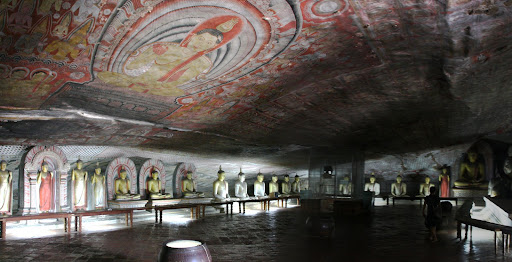Thai Airways took us from Colombo to Bangkok on their way-too-short 3 hour red-eye – certainly a terrible night of sleep. We stayed in Bangkok for two nights to enjoy some of the food but our intended destination was actually the ruins of Angkor near Siem Reap, Cambodia. The most direct land route to Siem Reap is through the border crossing at Poipet. Citizens of most countries must obtain a visa to enter Cambodia and while this can be done in advance, we opted to do it right at the border.
The border crossing at Poipet has a pretty bad reputation in terms of corrupt officials and transportation scams but if you read up on it in advance it really isn’t that bad. We had one tuk tuk driver try to take us to a visa agency that likely would have overcharged for the visas. After we were past the Thai side of the border we found the official Cambodian visa office. There is a large sign hanging in the office that plainly states “Tourist Visa $20″ but this wasn’t enough to deter the official, who was standing right below it, from telling us that the visa would be $20 and 100 Thai baht (about 3USD). We chuckled at his request and handed over $20 per person – our passports were given back a few minutes later. Visas in hand, we passed through immigration and into the hands of a transportation mafia that gets $9 for the 2 hour bus ride to Siem Reap – horrendously expensive by local standards but it was a decent enough bus. In reality, the transportation mafia gets $9 to take you not to Siem Reap but rather a place a few miles short of town where the tuk tuk drivers pick the crowd over like vultures.
Safely in Siem Reap, we started planning out our visit to the enormous Angkor ruins. The planning process is quite intimidating since there seem to be as many opinions on itineraries as there are stones in the temples. We settled on a three-day approach. On the first, we hired a Cambodian tuk tuk driver to take us to some of the more remote attractions. On the second and third days we borrowed bikes from our guesthouse and hit the closer sights.
I’m not going to babble on and on about the history of all the temples because, honestly, I can’t remember most of it. What I can say is that they are all quite old (800AD – 1400AD) and are in various states of being consumed by the jungle. Many are being actively maintained and refurbished (like Angkor Wat itself) but others are left as is. The ones with jumbles of rocks all over the place and trees growing out of them have an eerie atmosphere about them.
Bike riding on the second and third days was hard work. The weather was hot and humid, just as one would expect in Cambodia, but at least the terrain is flat and traffic was minimal. The one bit of excitement was seeing something green fall from above onto the back of my bike. I saw it just from the corner of my eye and thought it was a tree branch. Amy, who was riding just behind me, pointed out that it was a bright green snake!
My favorite temple at Angkor was Bayon. It is well-known because of the dozens of giant stone faces that decorate its towers. The 12th century temple also has a huge variety of meticulously carved reliefs that show different historic events and scenes from everyday life. I also noticed a labyrinth of hallways and tunnels in the lower levels that left me wishing that I had brought my flashlight.
The biggest nuisance we faced while visiting Siem Reap was flooding. Not only did it prevent us from visiting one of the main temple complexes (Ta Phrom) it greatly limited what we could do in town. The old section of Siem Reap is right next to the river and many blocks of it were under water – sadly, this was the same area of town where most of the restaurants and nightlife are to be found. Amy and I did manage to find a cheap local vegetarian place which was outside of town but even going there required peddling through knee-deep water on our bikes. What a mess.
All in all, we enjoyed Angkor and Siem Reap but we certainly found ourselves “templed out” after three days of touring. The ruins are unquestionably impressive but just about any metric and I can definitely see where someone with a keen interest in ancient civilizations could spend a week visiting.











